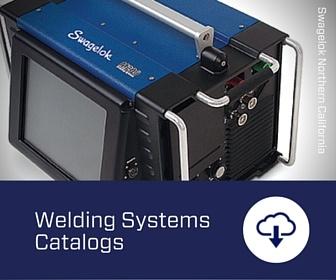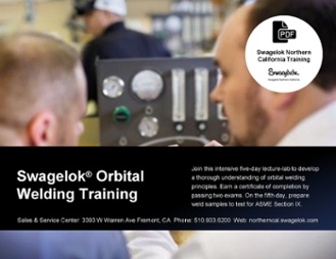Share this
Good Orbital Welding Still Relies On Human Choices
by Jeff Hopkins on 10/9/18 9:00 AM
A machine can perform only as well as the weld parameters set by the operator
"While a computerized orbital welder creates better, more consistent welds than a pair of human hands, the machine still needs a human to tell it what to do."
- From "Good Orbital Welding Still Relies on Human Choices"
While a computerized orbital welder creates better, more consistent welds than a pair of human hands, the machine still needs a human to tell it what to do. You have to choose the right electrode grind angle, arc gap, purge gas and other parameters. You also have to check the welder periodically as conditions change, to make sure it's still performing the way you want it to.
Tungsten electrodes
The electrode plays a major part in orbital welding. An orbital welding machine uses standard programs, and it can't make visual adjustment to differences in the grind of the tungsten. So here are a few things to consider when choosing an electrode and grind:
- Electrode grind angle is a trade-off. Shallow angles have more stability, but steeper angles give more penetration. The penetration factor is not as noticeable at current levels below 100 amps, where most orbital welding is done.
- Electrode tip diameter is another trade off. A small diameter gives ease of arc start, while a large diameter offers more power capabilities, penetration, and tungsten life. The diameter is a matter of choice, but it must remain constant between tungsten electrodes used on the same programs.
- Electrode material is again a matter of choice, but three types are the most common. Thoriated tungsten has been used by hand GTAW welders for years but is not the oxide of choice for orbital welding because it is slightly radioactive, has poor restart capabilities, and short service life. Ceriated tungsten is a good choice. Lanthanated tungsten is less available in the United States, but is an acceptable choice.
- Electrode size is a function of the current required for the weld and the orbital weld head requirements.
Swagelok Welding System (Video Overview)
Arc gap
A narrow arc gap gives you better penetration, heat input, ease of arc start, and stability of the arc. But to a large degree, the gap is controlled by the weld current and the roundness of the tubing. When the roundness of the tubing changes, the arc gap changes. That, in turn, causes the heat input to change. So choosing an arc gap is a compromise between the optimal narrow gap and how well your material dimensions are controlled.
Purge Gas
Orbital welding jobs most often succeed or fail because of purge procedures. Gas purity is important. Standard grade argon, for example is 99.95 percent pure, while research grade is 99.99999 percent pure. Then there's electronic grade, which has additional requirements such as lower oxygen and moisture content.
Normally, inside-diameter purge gases must meet or exceed the installed system gas purity. Head purge gases, on the other hand, usually are not considered as critical.
It's possible to use cheaper ID purge gases, mainly nitrogen, on larger size tubing but not in all materials. N2 is not as inert a contaminant in many systems as argon.
The ID pressure must be controlled at the weld point and can be affected by number of factors such as the length of the tubing, number of fittings or bends, amount of elevation change and any connected components such as valves or regulators.
Swagelok Welding System (Catalogs)
Checkup
Here are some times when you should verify the weld parameters:
- At the start and end of each shift.
- When the ambient temperature changes by more than 20 degrees.
- When you change any of the equipment, such as the weld head, weld head extensions or power supply (even adding or taking away an extension cord).
- When there's a change in the tube size or wall thickness.
If some of that seems unfamiliar or overwhelming, don't worry. We can teach you what you need to know through our Swagelok Orbital Welding Training Course. You can get the details by calling us at 510-933-6200 or through our website.
Swagelok Orbital Welding Training (Next Class 10/22/18-10/26/18)
More like this:
- With Proper Training, Orbital Welding Leads the Way (blog article)
- Six Things To Look For In An Orbital Welding Training Course (blog article)
- Designing For Weld Perfection (blog article)
Share this
- Archive (465)
- Assembly Services (207)
- About (100)
- Seal Support Systems (96)
- Best Practices (88)
- Training Services (74)
- Fittings (51)
- Semiconductor Applications (49)
- Hoses and Flexible Tubing (47)
- Regulators (44)
- Tubing (42)
- Grab Sampling Systems (32)
- Sampling Systems (32)
- Gas Systems (30)
- Services (30)
- Downloads (29)
- Valves (24)
- Application Support (18)
- Orbital Welding (17)
- Case Studies (13)
- Steam Systems (13)
- Frequently Asked Questions (12)
- Tools (12)
- Measurement Devices (7)
- Subsystems (6)
- Thermal Management (6)
- September 2023 (1)
- August 2023 (2)
- June 2023 (1)
- March 2023 (3)
- February 2023 (3)
- January 2023 (4)
- December 2022 (4)
- November 2022 (4)
- October 2022 (4)
- September 2022 (1)
- August 2022 (3)
- July 2022 (2)
- June 2022 (4)
- May 2022 (1)
- April 2022 (2)
- March 2022 (1)
- February 2022 (2)
- January 2022 (3)
- December 2021 (1)
- November 2021 (6)
- October 2021 (6)
- September 2021 (8)
- August 2021 (4)
- July 2021 (3)
- June 2021 (6)
- May 2021 (6)
- April 2021 (7)
- March 2021 (5)
- February 2021 (4)
- January 2021 (6)
- December 2020 (5)
- November 2020 (6)
- October 2020 (6)
- September 2020 (8)
- August 2020 (7)
- July 2020 (8)
- June 2020 (8)
- May 2020 (6)
- April 2020 (9)
- March 2020 (7)
- February 2020 (10)
- January 2020 (21)
- December 2019 (23)
- November 2019 (21)
- October 2019 (22)
- September 2019 (21)
- August 2019 (22)
- July 2019 (23)
- June 2019 (20)
- May 2019 (23)
- April 2019 (22)
- March 2019 (21)
- February 2019 (20)
- January 2019 (21)
- December 2018 (14)
- November 2018 (19)
- October 2018 (23)
- September 2018 (17)
- August 2018 (29)
- July 2018 (11)
- June 2018 (6)
- May 2018 (5)
- April 2018 (4)
- March 2018 (5)
- February 2018 (3)
- January 2018 (3)
- December 2017 (2)
- November 2017 (4)
- October 2017 (3)
- September 2017 (2)
- August 2017 (6)
- July 2017 (4)
- June 2017 (4)
- May 2017 (4)
- April 2017 (3)
- March 2017 (4)
- February 2017 (3)
- January 2017 (3)
- December 2016 (3)
- November 2016 (3)
- October 2016 (3)
- September 2016 (5)
- August 2016 (5)
- July 2016 (4)
- June 2016 (5)
- May 2016 (3)
- April 2016 (4)
- March 2016 (5)
- February 2016 (11)
- January 2016 (1)
- December 2015 (3)
- November 2015 (4)
- October 2015 (3)
- September 2015 (4)
- August 2015 (4)
- July 2015 (8)
- June 2015 (5)
- May 2015 (3)
- April 2015 (4)
- March 2015 (4)
- February 2015 (3)
- January 2015 (4)
- December 2014 (2)
- November 2014 (3)
- October 2014 (4)
- September 2014 (4)
- August 2014 (4)
- July 2014 (5)
- June 2014 (4)
- May 2014 (4)
- April 2014 (5)
- March 2014 (4)
- February 2014 (3)
- January 2014 (4)
- December 2013 (5)
- November 2013 (3)
- October 2013 (4)
- September 2013 (3)
- August 2013 (5)
- July 2013 (5)
- June 2013 (5)
- May 2013 (3)
- April 2013 (6)
- March 2013 (4)
- February 2013 (4)
- January 2013 (8)
- December 2012 (4)
- November 2012 (6)
- October 2012 (6)
- September 2012 (4)
- August 2012 (4)
- July 2012 (4)
- June 2012 (4)

.webp?width=210&height=70&name=StickyLogo%20(5).webp)




